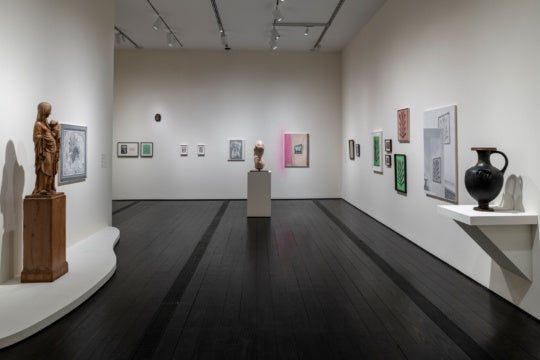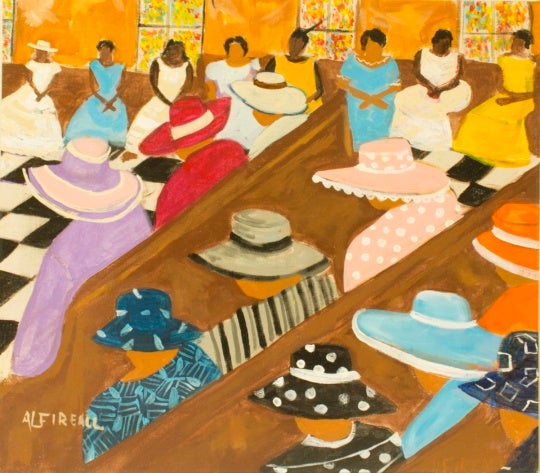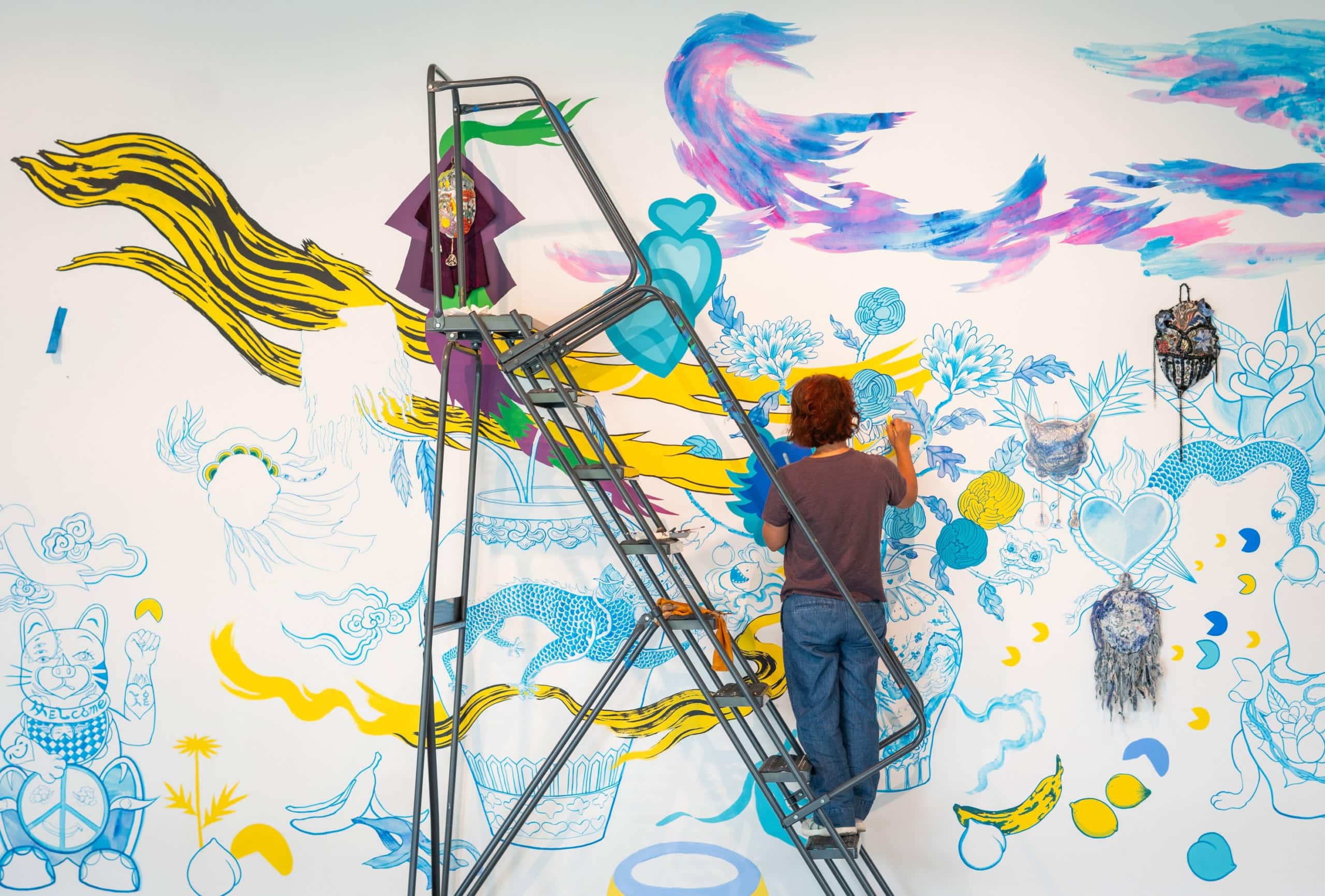
“Everything has a spirit,” Jiha Moon once told me, shifting a ceramic mask on the wall of her old Atlanta studio, its surface glinting with brushwork and embedded trinkets. “Even the funny things. Even the banana peels.”
Over the past two decades, Moon has built a body of work that is playful, sharply incisive, deeply personal, and unmistakably global. Born in Daegu, South Korea, Moon came to the United States in the late 1990s to pursue her MFA at the University of Iowa. That move set the stage for a lifelong negotiation between cultures, geographies, and aesthetics. “I came here thinking I had to become more ‘American’ as an artist,” she recalls.


She works in paintings, prints, ceramics, and large-scale installations, her works thrive on the friction—and fusion—of overlapping cultures. She layers Korean folk motifs with American pop culture and digital-age detritus, creating compositions where Buddhist spirits, talismans, and dragons rendered in traditional porcelain glazes coexist with emojis, lemons, lottery tickets, Facebook thumbs, and K-pop hairstyles. A tiger might appear beside a Maneki-Neko cat flashing a peace sign, or a porcelain vessel might sprout anime eyes. These juxtapositions aren’t meant to be ironic or shocking; they’re part of what Moon calls “cultural shapeshifting”—an intentional refusal to choose between worlds. Her work doesn’t try to resolve cultural tension—it revels in it. The visual density of her work mirrors the complexity of her identity: Korean and American, insider and outsider, sincere and tongue-in-cheek.
She described that old Atlanta studio as “ginormous. It was like a palace.” Her studio setup is a world apart in Tallahassee, where she now teaches at Florida State University. “There are no basements in Florida due to weather. So, we had to make it work—we turned the dining room into a painting space and the sunroom into a ceramics studio. FSU provided a studio for larger paintings on campus.” The life of an artist.
The shift from a well-established home base in Atlanta to a smaller Southern city came with some culture shock but also inspiration. “Atlanta is like my hometown in the US. I lived there for over twenty years. That’s the city I lived in the longest,” she says. “I’m really enjoying the nature here. In Georgia, I referenced the kudzu in my work. But here, it’s Spanish moss—it’s everywhere. So much greener. An appreciation of nature is a big part of our move.” Moon’s latest project, One An Other (2025), is a mural-sized explosion of color and form, installed in the lobby of the newly reopened Stanley Museum of Art at the University of Iowa—bringing her back, full circle, to the site of her MFA studies. It’s her largest mural to date and one of her most ambitious syntheses of painting and sculpture.
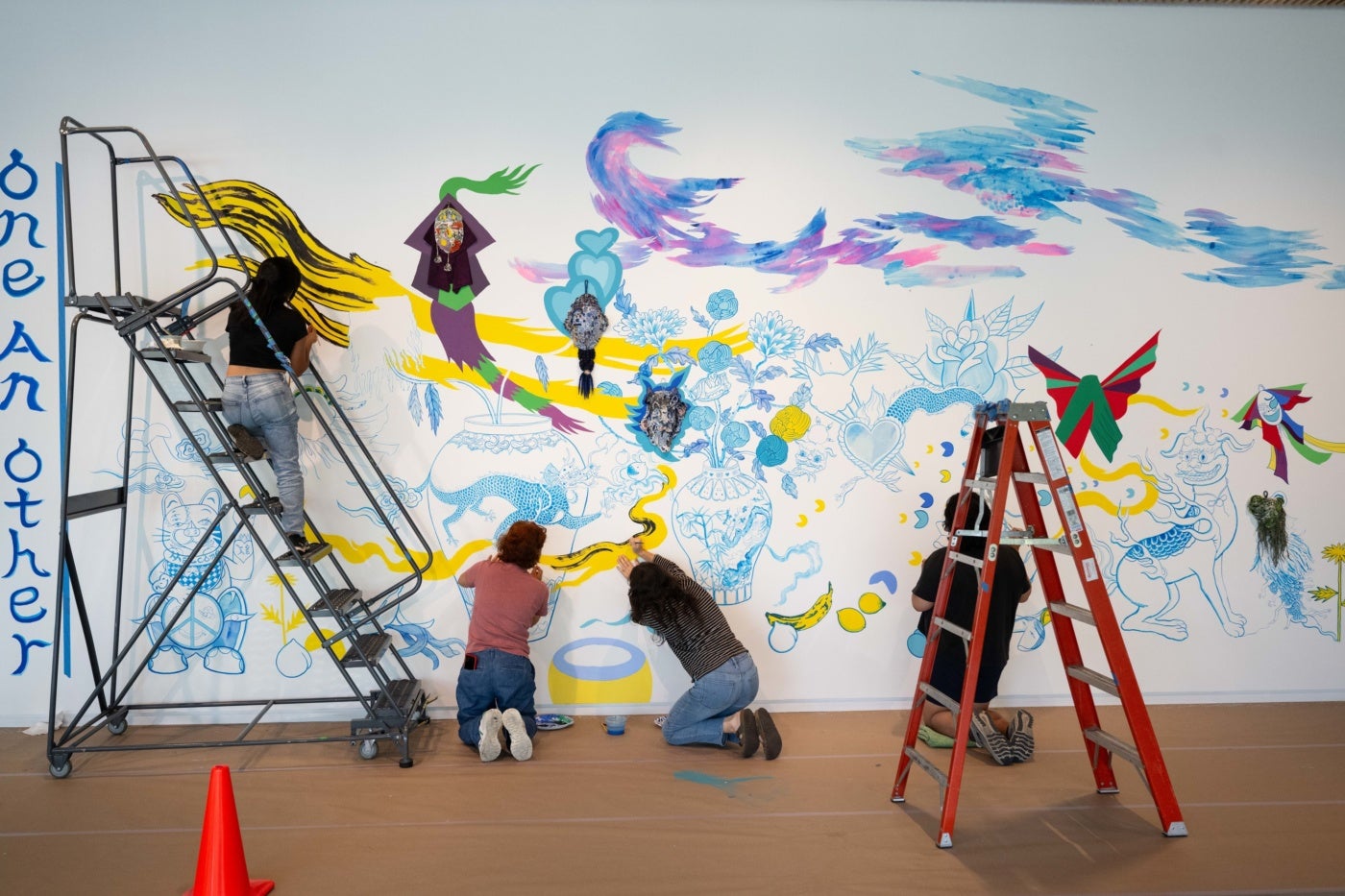
The work stretches over thirty feet across an entire wall in the museum’s atrium. It’s painted directly onto the wall in acrylic, interspersed with ceramic masks attached in strategic clusters. It feels like a convergence of her many worlds, both personal and artistic. From afar, it reads as a swirling tapestry of imagery. Up close, it reveals dozens of visual and material surprises.
Painted largely in cobalt blue, the mural evokes traditional blue-and-white porcelain from the Joseon Dynasty, long associated with immortality, spirituality, and the natural world—especially the sky and sea. East Asian ceramics: dragons, clouds, phoenixes, flowers, and waves all appear in finely brushed linework. But into this elegant vocabulary, Moon inserts contemporary, humorous, and sometimes surreal details: a banana peel, a watermelon half, Pac-Man pellets, and disembodied cartoon eyes peeking out from behind peonies. One of the central motifs is a sinuous yellow-and-black ribbon that twists through the mural like a strand of hair or a gust of wind. “I wanted it to be a connector, a spirit force,” Moon explains. “It’s like a path or a song that moves through the composition.”
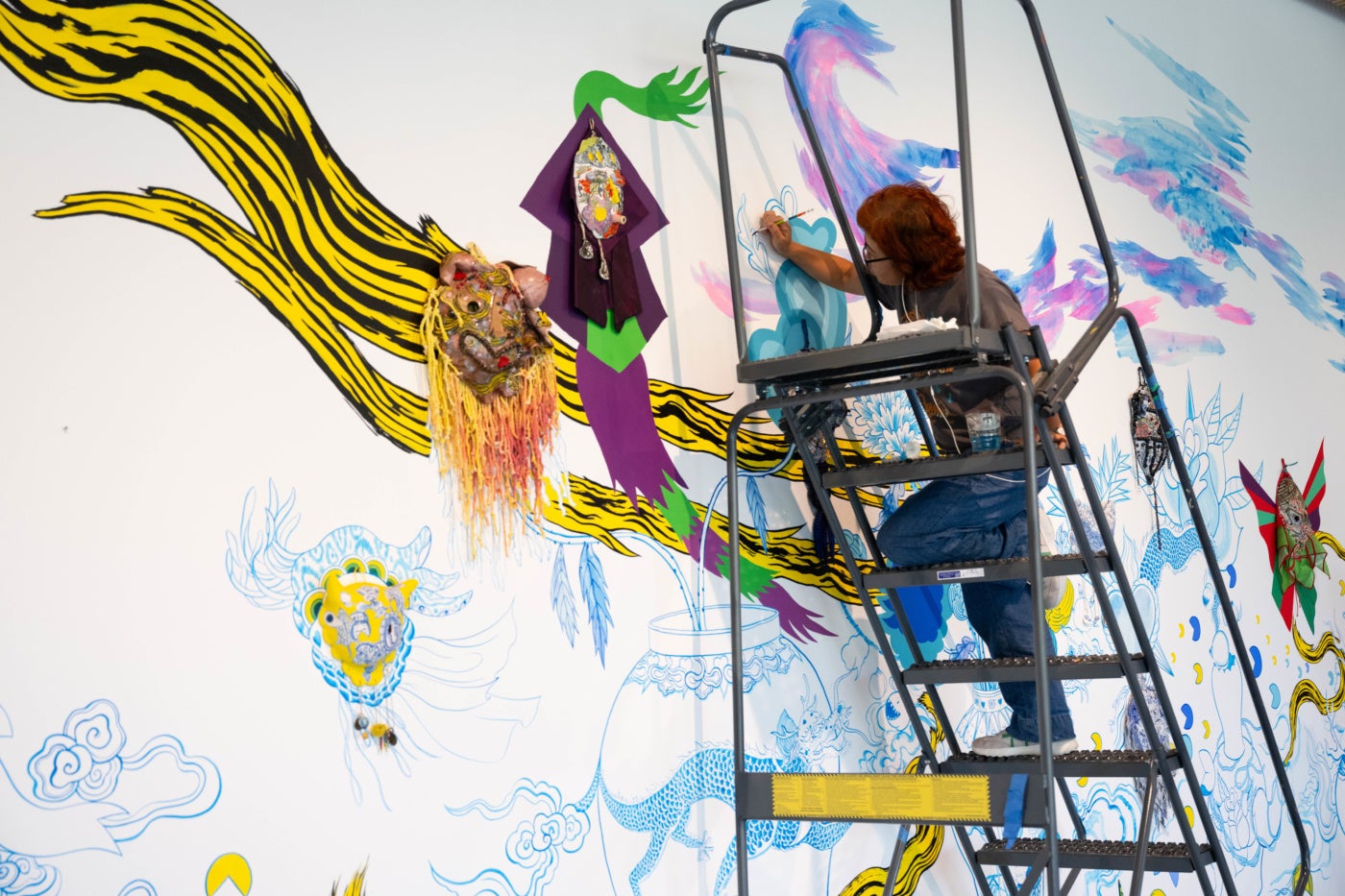
But the ceramic masks embedded into the wall make One An Other truly come alive. Moon builds and paints each, drawing on Korean tal masks and folk theatrical traditions. Some are glazed in the same cobalt tones as the wall, with others vibrant and deeply textured—featuring drips, beads, yarn, and even fragments of denim. A few have chains, like pendants or charms that hang down. These masks protrude from the flat surface, turning the wall into a stage and the painting into a chorus of voices. “There’s a different kind of energy that comes from 3D forms,” Moon says. “They’re not just part of the image—they confront you.”
The title, One An Other, offers a poetic suggestion of slippage between self and other, of reflection, doubling, and entanglement. It gestures toward the relational, toward the porousness of identity and perception. That idea runs through the mural. It’s not just a self-portrait; it’s a collaborative act. Moon assembled a team to create the mural and reflect her life across locations and communities. “I brought my family. Andy and Ollie helped me with the process,” she says, referring to her husband and son. “I brought two MFA students from FSU as assistants to help with the color blocking, and I also had two students from Iowa.”

The mural isn’t just about multiplicity—it embodies it. There’s no fixed narrative. Instead, it’s an ecosystem of shifting symbols—some borrowed, some invented, all in flux—that encourages viewers to find their own pathways through the imagery. Each contributor left their mark, woven into the layered iconography and calligraphic forms. The phrase “one another” becomes more than a title; it’s a gesture of gratitude, a reminder that the those who pass through people’s lives—family, students, mentors, collaborators—shape who they are and what they make. “I always identify myself as an object maker,” she says, “but the younger generation sees it differently. They’re very brave in adopting ephemeral materials that go away.” She says teaching has helped her stay open to new modes of making. “In my class, I said ‘awesome’ a lot, and my students told me, ‘Jiha, now people say slay.’ So, I made a ceramic piece with the word ‘slay’ in Korean folk-art style.”
Jiha Moon makes room for the weird, the funny, the sacred, and the everyday to coexist. Her art doesn’t ask to be decoded; it invites you to wander.
She’s drawn to long, slow processes—ceramic construction, layering glazes, repetitive painting. What holds it all together is her consistent sense of play. Her work doesn’t smooth over cultural contradictions; it lets them breathe, intersect, and sometimes clash. I asked her if she ever lets things fall apart. “Yes,” she says, “that’s the fun part. I like the unpredictability. Things make sense, then don’t make sense. It’s like a purgatory—and artists are more valuable in a purgatorial setting.”
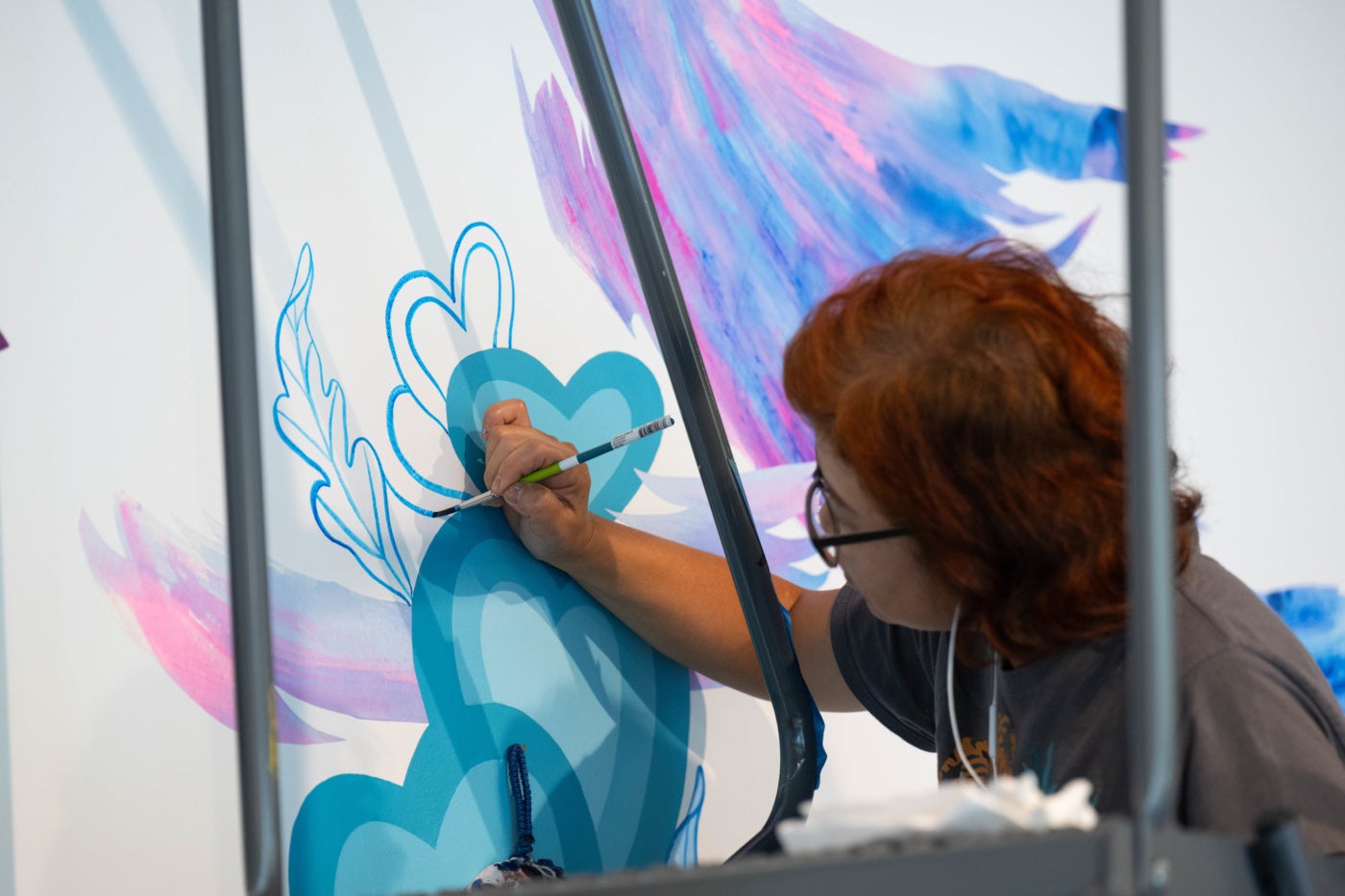
In Moon’s world, everything—every peach, every thread of yarn, every slip of clay—is alive with possibility. Her work hums with the energy of things not entirely settled, not always just one thing or another. In that space of multiplicity and transformation—what she calls purgatory—her voice is most evident. Whether painting on walls, shaping clay in her sunroom, or guiding a new generation of artists, Jiha Moon makes room for the weird, the funny, the sacred, and the everyday to coexist. Her art doesn’t ask to be decoded; it invites you to wander. To get sidetracked. To find your own way through the spirit force that winds—like a ribbon—through it all.

